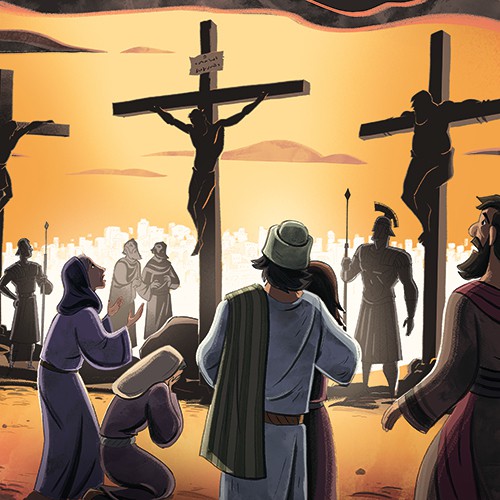The Crucifixion of Jesus
 The story of the crucifixion of Jesus is found in all four Gospels (Matt. 27:32-56, Mark 15:21-41, Luke 23:26-49, and John 19:16-37). This alone underscores its significance to the Gospel writers and the early church. But in addition, the fact that Jesus died as a sacrifice carries huge theological and personal importance for all of us who claim to be Christians. It’s possible that more has been written about the crucifixion of Christ than any other single topic in Christian history. This article will attempt to affirm what the church has historically believed. For another introductory article about the crucifixion, go here.
The story of the crucifixion of Jesus is found in all four Gospels (Matt. 27:32-56, Mark 15:21-41, Luke 23:26-49, and John 19:16-37). This alone underscores its significance to the Gospel writers and the early church. But in addition, the fact that Jesus died as a sacrifice carries huge theological and personal importance for all of us who claim to be Christians. It’s possible that more has been written about the crucifixion of Christ than any other single topic in Christian history. This article will attempt to affirm what the church has historically believed. For another introductory article about the crucifixion, go here.
What Happened
The details of Jesus’ crucifixion provided by the Gospel writers are part of a larger narrative that covers the final 24 hours (roughly) of Jesus’ life. This includes the Last Supper (the Passover Meal), Jesus’ time in the garden where He prayed and was tempted to forego the cross, His trials, and His beatings by the Roman soldiers. The passages noted above include only the events directly related to His crucifixion once He began to journey to Golgotha until He actually died on the cross.
There is a good deal of detail provided by the four Gospel writers when it comes to the actual crucifixion. We will not seek to cover all the detail. Rather, we want to provide some general reflections on the crucifixion that we feel are most appropriate for parents and those who teach the Bible to children.
The Crucifixion of Jesus and the Resurrection are Connected
It’s always important to remember that the cross cannot be rightly understood without connecting it to the resurrection. It was at the cross that Jesus defeated the power of death and evil. If Jesus were not also resurrected, then His victory over death would be meaningless and an empty claim. Many have spiritualized Jesus’ victory and suggested that it doesn’t matter whether Jesus was resurrected. Such a suggestion ignores the clear and overwhelming claim of all of the Gospel writers. They certainly believed Jesus was physically (bodily) raised to new, physical life.
But it’s also important to recognize the broader biblical teaching that all of creation (the physical and spiritual) are one thing. It’s not possible to separate the physical implications of sin and evil (physical death) from the spiritual implications of sin and evil (spiritual death). When Jesus defeated death (the consequence of sin and evil), He defeated it at every level; both physical and spiritual. His physical crucifixion, then, is meaningless without the physical resurrection that took place on Resurrection Sunday.
The Crucifixion and Atonement
The Bible is clear that humankind carries sin and evil within us. We need forgiveness from the consequences of sin and victory over the power of sin in our lives. We call this idea of being forgiven and made right before God “atonement.” There are many theories of atonement and scholars have used a variety of ways to illustrate how Jesus’s crucifixion accomplished atonement for God’s people. Most scholars agree, however, that it was by the crucifixion that Jesus “made atonement” for us (Heb. 9:14).
We might find the horror of the crucifixion difficult to ponder. That’s as it should be. What Jesus suffered for us on the cross is truly beyond our comprehension. The cross represents the worst that Satan could bring against the Son of God. The pain, anguish, and suffering Jesus endured is repulsive and hard to imagine. But that’s part of the “beauty” of the cross and God’s plan. It is through death that God defeats death and now offers new life. Jesus experienced the worst of death in order to provide the best of life. The cross demonstrates the Kingdom principle that Jesus spelled out in Mark 10:42-44…
Jesus called them over and said to them, “You know that those who are regarded as rulers of the Gentiles dominate them, and their men of high positions exercise power over them. But it must not be like that among you. On the contrary, whoever wants to become great among you must be your servant, and whoever wants to be first among you must be a slave to all.
It’s no coincidence that Jesus then goes on to say…
“For even the Son of Man did not come to be served, but to serve, and to give His life — a ransom for many” (Mark 10:45).
Somehow, Jesus’ horrific death acquired atonement for us (Gal. 1:4). This is a foundational truth to the entire gospel.
Jesus Was More than a Good Man
Some have tried to interpret the crucifixion of Jesus simply as an example of great love. But this denies the comprehensive teaching of the New Testament. If Jesus were merely a good man who set an example of loving others to the point of death, then His death makes no real difference beyond encouraging us to be loving as well.
Certainly, Jesus did set an example of love for us to follow. But the New Testament is clear that Jesus accomplished something on the cross that we (and creation) needed. Jesus defeated sin, evil, and death when He died on the cross. This not only makes atonement possible for us as individuals, it truly changes everything. Just as the sin of Adam and Eve had a cataclysmic impact on humanity and creation, so the crucifixion made possible the final and ultimate redemption of creation (Rom. 8:19-23).
It’s hard to overstate the importance of this point. Jesus was so much more than a good man. He was the Son of God; the Second Person of the Trinity. It was God Himself who bore the cross. Only God could have accomplished genuine atonement. When we look upon (or imagine) Jesus suffering on the cross, it is God Himself hanging there to do what only He could do to accomplish atonement for our sin.
Teaching Children About The Crucifixion of Jesus
We shouldn’t be afraid to introduce children to the crucifixion. Certainly, we don’t need to frighten them or disturb them with horrifying images and details. But it’s okay for them to know it happened and that Jesus suffered terribly to accomplish our forgiveness. We hope the illustration we use for the crucifixion strikes an appropriate balance between showing the darkness of the event and the graphic details of the event.
It is, of course, up to the individual parent or teacher to discern what is best for their child(ren). We just believe that it shouldn’t be avoided when the parent or teacher determines it is appropriate.
Another factor that can influence whether and when children learn about the crucifixion is the calendar. Interestingly and reasonably, churches tend to teach about Palm Sunday on the Sunday before Good Friday (Palm Sunday) and then cover the resurrection on Easter Sunday. Again, this is reasonable. But, it also means the church and families may need to be proactive in helping children know what happened at the cross and why.
Perhaps the crucifixion should be covered to some degree on Palm Sunday to help contrast the joy and celebration of the Triumphal Entry with the horrors of the crucifixion less than a week later. Or, the crucifixion can get addressed before celebrating the resurrection on Easter Sunday. After all, it’s hard to explain someone coming back from the dead without explaining how He came to be dead in the first place. Families and churches that observe Good Friday certainly have the perfect opportunity to introduce the crucifixion of Jesus to children at that time. This helps place the crucifixion in the context of Jesus’ final week, which elevates all of the events of Passion Week.
The crucifixion is one of the deepest theological topics we as adults might ever wrestle with. How can we communicate it in such a way that a child can understand what it means? That’s a great question and the answer will be influenced by the maturity of your kids. However, the Bible provides a pretty simple way of explaining the point of the cross.
The night before His death, Jesus Himself provided an explanation of the events that would unfold the next day. As He broke the bread of the Passover Meal and gave it to His disciples, Jesus noted quite simply… “For this is My blood that establishes the covenant; it is shed for many for the forgiveness of sins” (Matt. 26:28). And here we have a solid, but simple explanation of the cross… Jesus shed His blood for the forgiveness of sins.
How the shedding of blood accomplishes the forgiveness of sin is a deeper topic that adult theologians continue to wrestle with. But children tend to be accepting of simple truths without demanding deeper explanations. If we teach them that Jesus died on the cross for the forgiveness of sins, that will reflect biblical language (from Jesus Himself) and likely will be sufficient for most children. The crucifixion teaches all of us, including children, that Jesus died on the cross for the forgiveness of sins.
One of the most important things you as a parent or teacher can do when it comes to teaching children about the crucifixion of Jesus is to develop a better understanding of it yourself. We hope this article helps move all of us in that direction.
You can find all of the activities related to the Crucifixion of Jesus here.



